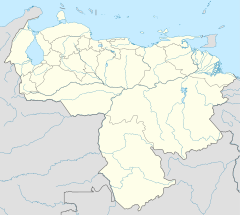Birthplace of Simón Bolívar
| Birthplace of Simón Bolívar | |
|---|---|
| Casa Natal del Libertador Simón Bolívar | |

Simón Bolívar's birthplace, Caracas
|
|
| General information | |
| Architectural style | Spanish Colonial |
| Location | Caracas, Venezuela |
| Country | Venezuela |
| Coordinates | Coordinates: 10°29′43″N 66°55′1″W / 10.49528°N 66.91694°W |
| Completed | 1643 |
| Inaugurated | 5 January 1921 |
| Renovated | 1920 |
| Client | Venezuelan government |
| Website | |
| http://casa-natal-del-libertador.webnode.com.ve/ | |
The Birthplace of Simón Bolívar (Spanish: Casa Natal del Libertador Simón Bolívar) is a seventeenth-century house in the Venezuelan capital city Caracas where the hero of Venezuelan and Latin American independence, Simón Bolívar, was born. Now a significant tourist attraction, the building is located in a little street off the Plaza San Jacinto, a block east of the Plaza Bolívar. It is one of only a few houses from the colonial era which survive in central Caracas.
One of the adjacent buildings serves as a Bolivarian museum (museo bolivariano). The birthplace and museum together present memorabilia connected with Bolivar and the Venezuelan War of Independence, along with weapons and furniture of that period.
The house on San Jacinto Street was completed in the 1640s. Bolivar was born to Doña María de la Concepción Palacios y Blanco and Coronel Don Juan Vicente Bolívar y Ponte in the bedroom here on 24 July 1783, and was the fourth child of the aristocratic couple of the Creole family who had migrated from Spain 200 years earlier. In 1806, the house was sold to a relation of Bolívar called Madriz. The house remained in his family until 1876 when it was bought by President Antonio Guzmán Blanco. Guzmán Blanco was an admirer of Bolívar, and erected his equestrian statue in the Plaza Bolivar.
Reconstruction of the house was ordered on October 28, 1916, with the purpose of preserving Venezuela's cultural heritage, and to honor its national hero, but it was not until 1920 when the house actually underwent reconstruction with added refinements. It was inaugurated on 5 January 1921 on the anniversary of the Battle of Carabobo. The building became a listed National Monument on 25 July 2002.
The single-storey building occupies a relatively narrow plot, 23 meters wide and 60 meters deep. It has wide corridors and courtyards and patios.
The reconstruction is Spanish Colonial in character, but the aim of the restorers was to enhance the building, rather than adopt criteria of strict authenticity. New materials were introduced; for example the facade facing the street has been refaced in stone, which is atypical of colonial-era houses in Venezuela. Other walls are whitewashed: the structure underneath is now made of brick, although it was probably made of adobe originally.
...
Wikipedia

